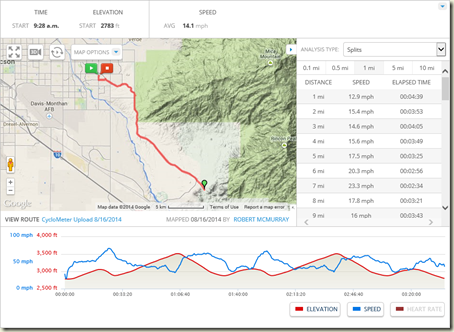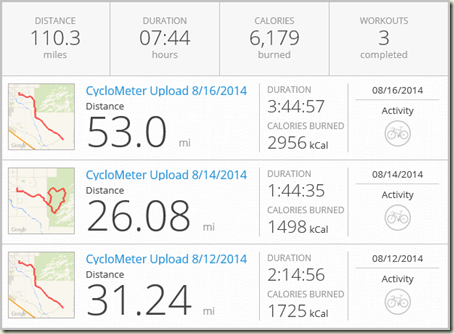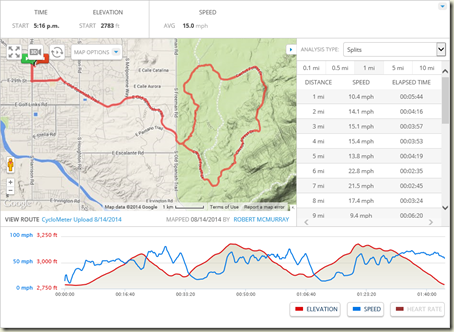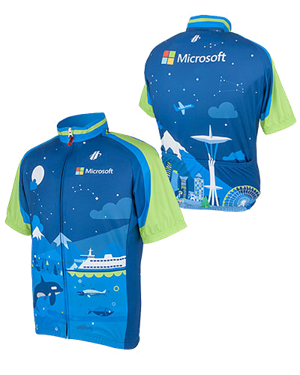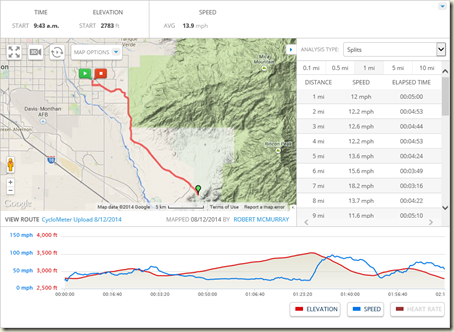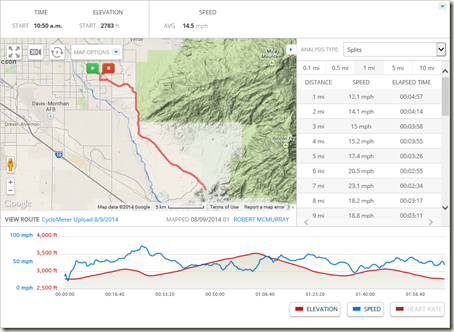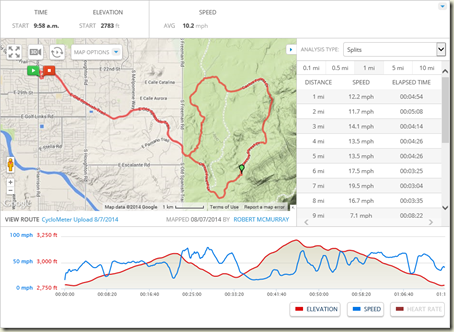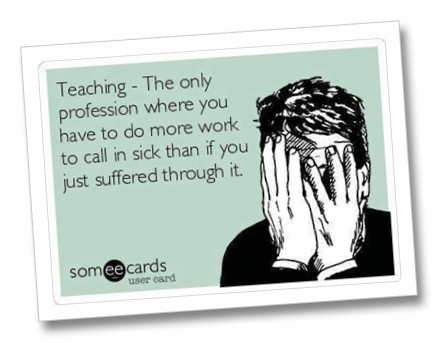Ride Notes for August 16th, 2014
16 August 2014 • by Bob • Bicycling
I got up today with the intention of riding 50 miles, and I’m happy to say that I stuck to that plan. For the most part, anyway. My chosen route was to ride the 15 miles or so from my house to Colossal Caves, then backtrack 10 miles to the entrance of Saguaro National Park, then 10 miles back to Colossal Caves, and then 15 miles home. All of those distances were only estimates, though – my actual number of miles ridden for the day was 53, so I exceeded my goal by a few miles. (And that’s okay by me.)
I set my alarm for 8am this morning, with every intention of heading out for my ride by 8:30am. However, when I woke up I discovered that Kathleen was making waffles and bacon, so we had a leisurely breakfast together as we chatted about our respective weeks. As a result, I didn’t get on the road until sometime around 9:30am, but quality time with my spouse is worth more than a silly bike ride – so my delay was worth every minute.
I chose to ride 50 miles because it works out nicely riding to Colossal Caves and back a couple times; there are a lot of hills, so it keeps me working the whole time. But I wanted to ride at least 43 miles today because that would help me hit the century mark (100 miles) for the week. That being said, going past my goal is not bad, either. And with that in mind, I logged 110 miles on the bicycle this week – with nearly 6,200 calories burned.
The ride was mostly uneventful, although I saw two distracted drivers swerve off the road ahead of me. Had they lost their concentration when they were speeding past me… well, let’s just be thankful that the worst-case scenario was averted.
A few weeks ago I rode a metric century (100km), although I did just about everything wrong for that ride: I stayed up all night the night before (so I had been up for 24 hours when I began the ride), I barely consumed 200 calories worth of food before heading out, and I ate nothing during the 4.5-hour ride. As someone from a local bike shop commented, “You’re the guy we’re going to find lying by the road some day.” With that in mind, it was better to have had a real breakfast before heading out today, and I made sure to down a package of Gu at the 15-mile, 26-mile, and 37-mile points. I drank several liters of water and Gatorade during today’s ride, yet I still managed to lose a little over a pound of weight during the endeavor.
I had one intentional stop during the ride; I pulled into the hydration station at Saguaro National Park near the mid-point of my ride in order to refill all of my water bottles. I met another cyclist while I was there; she had just completed her loop around the park and was headed home shortly. (She was recovering from a recent illness, and she was lamenting the fact that she had to pull off the road near the middle of the "Widow Maker" hill on the back part of the ride. As someone who hates that hill, she truly had my sympathy.)
That being said, I also had one unintentional stop during the ride - as I was just starting up the long, 5-mile hill on the last leg of my route to Colossal Caves, I somehow managed to drop my water bottle. As a result, I brought the bike to a quick halt, and I nearly fell over since my shoes were immobilized in toe clips. But I managed to get one foot out before I hit the ground, and I laid the bike on its side while I ran back for my bottle. Once I had that safely stowed, I climbed back on my bike and I began the laborious process of riding uphill. (Although I was upset with myself for having lost all of my forward momentum when I stopped.)
I saw two good-sized tarantulas on the road, and I managed to miss both of them. (Good thing, too – I am sure that tarantula guts are no fun to clean off.) I saw lots of hawks in flight, which was better than the usual gaggle of turkey vultures who follow me when I'm riding at mid-day in 100+ temperatures. (Seriously - I am followed by vultures a lot when it's really hot. I wonder if they know something I don't?)
For the future, I’m looking into making a small change to this ride: instead of riding all the way to Colossal Caves on Old Spanish Trail, I can turn off onto Pistol Hill Road (I love the name!) about a mile before the caves, then turn onto Camino Loma Alta, which will take me back to Old Spanish Trail. This adds a few miles to the ride, and it cuts out the barely-maintained last mile to the caves (which hurts to ride). I seem to be the only cyclist who is riding all the way to the caves, so I’m pretty sure that all of the other cyclists are using this alternate route. If I combine that route with my current plan of riding twice to the caves, I might be able to extend the ride to 60 miles.
Ride Stats:
- Distance: 53.0 miles
- Start Time: 9:28am
- Duration: 3:44:57
- Average Speed: 14.1 mph
- Peak Speed: 31.3 mph
- Altitude Gain: 2,932 feet
- Calories Burned: 2,956 kcal
- Starting Temp: 82 degrees
- Ending Temp: 94 degrees
8/17/2104 Update: I was on the verge of falling asleep as I wrote this blog, which is unlike me; I usually head off to bed around 2am every day, so it was extremely atypical for me to be that tired so early. Nevertheless, I climbed into bed after publishing the original blog, and I slept for 11 hours, which is also not my normal behavior. I must be getting older. ;-]
Ride Notes for August 14th, 2014
14 August 2014 • by Bob • Bicycling
Once again, today was supposed to be one of my “Short Days,” but I decided to shake things up just a bit: instead of riding the usual 17-mile trek from my house through Saguaro National Park and home again, I doubled my ride around the park, which yielded a 26-mile ride.
The days have been growing shorter as we head into Fall and Winter, and sunset is getting a little earlier each day. A few weeks ago sunset was around 7:30pm, but I checked earlier today and saw that sunset was going to be at 7:08pm. With that in mind, I did some quick math: if I assumed that it takes me 20 minutes to the park and 20 minutes to return home, and it takes 40 minutes for each loop around the park, that means that it should take about two hours to complete the ride. (In all actuality, it takes me less time for each phase of the ride, but I like to add a little buffer in case of weather.)
With that in mind, I knew that I needed to head out as close to 5pm as possible, but I needed to lock up our puppy before I left and she was being uncooperative, so that delayed my start time until quarter after the hour.
I decided that some music would be nice for today’s ride, so I loaded NeedToBreathe’s Studio Album Collection onto my cell phone, and I had that playing throughout the journey. (No earbuds, though - I only used the phone’s speaker.)
I was also wearing my new riding jersey today, which I bought a few days ago. I’m liking it a lot, and it has lots of great artwork that reminds me of my years in the Pacific Northwest.
The day was predominantly overcast, which made it seem like the sun was already setting by the time that I arrived at the park. Nevertheless, I started with earnest, and I managed to complete my first loop around the park in 36 seconds less than my previous personal best. (It’s the little victories that make your day.) I felt like I was riding a little slower my second time around the park, and I was certainly climbing the “Widow Maker” hill a little slower than my first loop. But somehow I made back for lost time, because my GPS showed that it took me just over 34 minutes to complete each loop around the park, with an average of a little over 14mph for both loops.
I have to admit, riding around the park a second time is difficult, because I’m pretty tired after my first loop. At times I have to rely on some old Army training psychology for perseverance; sometimes you just have to tuck your head down and push on. It also helps that the park is a one-way street: once I’ve started my second loop, I’m committed to completing the course.
The sun was visibly racing toward the far horizon as I completed my second loop around the park and started my 4.5-mile trek homeward, so I made sure to turn on all of my lights to avoid being hit by a car. (Today’s motorists are inattentive enough as it is.) I expected the second loop around the park to extend my ride to 25 miles, but for some reason my GPS indicated that I had ridden a little over 26 miles. I have no idea how that happened, but I won’t argue with it.
Ride Stats:
- Distance: 26.1 miles
- Start Time: 5:16pm
- Duration: 1:44:35
- Average Speed: 15.0 mph
- Peak Speed: 32.4 mph
- Altitude Gain: 2,020 feet
- Calories Burned: 1,498 kcal
- Starting Temp: 85 degrees
- Ending Temp: 84 degrees
Quick Algebra Pop Quiz: The loop around Saguaro National Park is 8 miles. I passed a guy running in the opposite direction at the 6-mile mark on my first loop around the park, and I passed him again at the 3.5-mile mark on my second loop. If I was averaging 14mph around the park, what was the runner’s average mph around the park? ;-)
Ride Notes for August 12th, 2014
12 August 2014 • by Bob • Bicycling
Today was supposed to be one of my "Short Days," meaning that I would ride my usual 17-mile trek from my house through Saguaro National Park and home again. But I had the day off, so I decided to ride a Metric Half-Century (50km) from my house to Colossal Caves and back.
This past Saturday the same ride had taken me a little over two hours, and I was hoping that I could improve on that and complete the ride in less than two hours. Sadly, this was not going to be possible. I discovered as I started out that I was riding into a stiff headwind all the way to Colossal Caves, which ultimately added six minutes to my total ride time. (Actually, it probably would have added more, but I intentionally rode faster than normal on my way back from Colossal Caves to make up for lost time.)
That being said, the strong headwind made climbing a lot of the hills on the road to Colossal Caves very difficult to negotiate, and I found myself having to downshift a lot to compensate; periodically I had to downshift while riding downhill just to fight the winds that hit me in the face as I crested the various hills that exist between the 10-mile and 15-mile mark on my way to the caves.
As I mentioned the other day, I have done this ride often enough to recognize most of the scenery along the way, so today I completed most of the ride with the screen turned off on my phone to conserve the battery. (Note: I turned on the screen once I hit the 10-mile mark so I could see how close to the caves I was getting, because the terrain between 10-miles and 15-miles contains the worst of the hills, and then I turned it off for the ride home.)
As I rode through the bottom of a wash at the 10-mile mark, I noticed a cow chewing its cud behind a fence off to the right of the road. I mustered up my best cow impression and I called out a friendly "Moo!" as I passed by, but she simply eyed me with contempt, as if to ask, "Why does everybody do that?"
On my way back from the caves, there is a certain point where I pass a sign which reads, "Tucson - 10 Miles." I have to admit, it is momentarily demoralizing to realize that you are on a bicycle in the middle of the desert and 10 miles from town.
Ride Stats:
- Distance: 31.2 miles
- Start Time: 9:43am
- Duration: 2:14:56
- Average Speed: 13.9 mph
- Peak Speed: 33.6 mph
- Altitude Gain: 2,152 feet [See Below]
- Calories Burned: 1,726 kcal
- Starting Temp: 90 degrees
- Ending Temp: 94 degrees
Note: Something appears to be seriously off with the altitude gain computation in my GPS application for my phone. I have done this ride several times, and the altitude gain is always well over 1,800 feet. For today's ride it said the altitude gain was 387 feet, which was totally bogus. When I analyzed the GPS data from my ride in an external application, I got the 2,152 feet that I listed above. So something is definitely amiss. Grrrrr.
Ride Notes for August 9th, 2014
09 August 2014 • by Bob • Bicycling
I took it somewhat easy today - Saturdays are supposed to be my long days, but I had a bunch of items on my "Honey Do" list that needed to be done, so I simply rode a metric half-century (50 kilometers / 31 miles). I might have considered adding Saguaro National Park to my ride in order to add another 8 miles to my distance, but I realized sometime after I left the house that I had left my annual pass for the park at home. Which is just as well, since I had told Kathleen that I was only riding 30 miles - from our house to Colossal Caves and back.
Overall the ride to Colossal Caves was not that bad; I've made the trek a few times, and I'm getting to know the road a little better. This means I'm learning when to push myself a little harder, and when I should reserve some energy for bigger obstacles in my future. For example, I know that the 15-mile journey from my house to Colossal Caves has a slight gain for the first 4.5 miles, then it's downhill for a few miles, then it's mostly flat for a few miles, and the final five miles are mostly uphill (with the worst near the end). All of the uphill & downhill parts of the trek remind me lyrics from the song "Spinning Wheel" from the late 1960s: "What goes up, must come down." Except it's the other way 'round: "What goes downhill, must go back uphill again." This is a sad reality of topography.
There was a bad headwind on my way back, and that undoubtedly added a few minutes to the ride, which was unfortunate because I was striving for an even two-hour ride for the 30-mile distance from my house to the caves and back, but I arrived home 8 minutes behind that schedule. Not for lack of trying, though. For example: a guy passed me around the 20-mile mark, but I was able to catch him over the next six miles as we got to the part of the ride which meanders uphill from Jeremy Wash. He turned off into Saguaro National Park as I continued homeward, so it's entirely possible that he was reserving his strength for the "Widow Maker" hill in Saguaro National Park around the 3.5-mile mark. I ran out of water when I was about 1.5 miles from my house, which wasn't too bad. I knew that I was close and I had a bottle of Gatorade waiting for me in the fridge, so I didn't attempt to hold anything in reserve.
I tried an experiment for today's ride: during my time in the military, I had something of a ritual on the days when I would to my long distance runs, (e.g. 10K races or half-marathons), where I would have scrambled eggs about an hour before the run, and I would take aspirin before I started the run. With that in mind, I tried something similar: I scrambled three eggs for breakfast and ate those about an hour before the ride, then I took a mixture of migraine medicines before heading out (aspirin, acetaminophen and ibuprofen). I also had a package of Gu right before the ride, and I had another package at the 15-mile mark. In the end, I have no idea if any of this helped.
Ride Stats:
- Distance: 31.1 miles
- Start Time: 10:50am
- Duration: 2:08:28
- Average Speed: 14.5 mph
- Peak Speed: 30.8 mph
- Altitude Gain: 1,808 feet
- Calories Burned: 1,764 kcal
- Starting Temp: 90 degrees
- Ending Temp: 94 degrees
Ride Notes for August 7th, 2014
07 August 2014 • by Bob • Bicycling
Today was one of my “Short Days,” meaning that I would ride my usual 17-mile trek from my house through Saguaro National Park and home again. That being said, I did something different today – I have always ridden solo, but today I rode with David, who is an old friend of mine from high school.
I have to mention that the idea of riding with someone else had me worried for two primary reasons:
- What if he rides faster than I do and I can’t keep up with him?
- What if he rides slower than I do and he can’t keep up with me?
The second concern seemed less-likely, but I didn’t want to hold up someone who was way outside my range as a cyclist. As it turns out, my concerns appeared to have been for naught, as we seemed to ride at a similar pace.
There was one great advantage to having someone else with whom to ride: as we rode up the “Widow Maker” hill on the back side of the park, we talked about guitars for a lot of our journey, which helped to take my mind off my normal thoughts for that part of the ride. (Note: I am typically thinking something like, “I hate this!!! Why am I doing this to myself???”)
That being said, as we stopped at the hydration station near the entrance to the park, we met up with several other cyclists who were all lamenting about the infamous hill on the back side of the park. With that in mind, David needed to take a couple of breaks during our ride around the park, which I completely understood; this can be a very taxing course, and I needed to take a few breaks during several of my earlier attempts.
Ride Stats:
- Distance: 17.0 miles
- Duration: 1:40:00
- Average Speed: 10.2 mph
- Peak Speed: 31.9 mph
- Altitude Gain: 919 feet
- Calories Burned: 909 kcal
Ride Notes for August 5th, 2014
05 August 2014 • by Bob • Bicycling
Today was one of my "Short Days" for cycling - I've been trying to get into a regular riding schedule where I take it easy on Tuesdays and Thursdays and ride just 17 miles. (4.5 miles from my house out to Saguaro National Park, around the 8-mile loop, and 4.5 miles back home.) This has slowly become my "default ride," and I ride around the park often enough for the gate guards recognize me when I arrive. There were a few more cyclists on the road today, which was a nice change. Usually I seem to be riding alone, and that is due to the fact that I will start a ride when the temperature is well over 100 degrees, when most cyclists won't dare to ride. (Or maybe they're simply smart enough not to leave the house. Hmm.) That being said, the temperature was hovering around 100 degrees when I left home, so it was something of a surprise to see other cyclists on the road.
Today was my first day back on the bicycle after my 100K ride this past Saturday, which had depleted almost all of my energy for the rest of that day. With that in mind, I was a little nervous about how my legs would hold up during today's outing, and surprisingly I didn't seem to be suffering any lingering ill-effects from my self-imposed abuse the other day. That being said, as I was making my way around the park, I could tell that my pace was a little better than usual, so I decided to press a little harder when possible, and as a result I completed the 8-mile loop in 34:47, which beat my previous personal best by a little over 2 minutes. This also bumped me up to 4th place (out of 107 riders) on MapMyFitness for the Saguaro National Park loop. Of course, that statistic only accounts for the riders who bother to upload their times to MapMyFitness; I'm sure that there are plenty of better riders who don't upload their times. Still, it's nice to know that I'm riding faster than somebody, because I usually think that I'm riding pretty slowly as I slog my way up some of the bigger hills around the park.
But that being said, I always cycle around Saguaro National Park in the middle of my ride, whereas many cyclists drive to the park and simply ride around the 8-mile loop. I'd like to think that the people who are riding faster than me are also riding a few miles before and after their ride around the park, but I can never be sure. Still, my overall time for today's ride was 20 minutes faster than I did a month ago, so that's something for me to be happy about.
Ride Stats:
- Distance: 17.0 miles
- Duration: 1:10:30
- Average Speed: 14.5 mph
- Altitude Gain: 1,243 feet
- Calories Burned: 964 kcal
Ride Notes for August 2nd, 2014
02 August 2014 • by Bob • Bicycling
I rode a metric century (100 Km) today, although that wasn't my original intention. I had planned to ride 50 miles (twice from my house to Colossal Caves and back). That being said, when I looked at the weather reports yesterday, they all predicted that thunderstorms would descend on Tucson at 10am, which meant that I should leave the house around 6am in order to have plenty of time to complete the ride and get home. Anyone who is familiar with me knows how much I hate mornings, but I'm pretty good with late nights, so I hatched an odd plan - stay up all night, and then go on the ride. That probably wasn't the brightest idea, but it's what I decided to do.
I managed to get on the road by 6:15am, and by the time I had finished 50 miles several hours later, the storms hadn't started, and I hadn't reached the point of muscle failure, so I decided to tack another 10 miles onto the ride. Once again, this may not have been the brightest idea, but once I started around Saguaro National Park, I was committed to the endeavor. In the end, my cell phone died, which I used for a GPS, so I'm not exactly sure how many miles I went over 60, but I'm certain that I hit my 100 km goal. Just the same, when I finally arrived home after four-and-a-half hours of riding and no sleep in 26 hours or so, I was more exhausted than you can imagine. Even so, today's ride pales in comparison to my friends who just finished the RAMROD (Ride Around Mount Rainier in One Day).
I usually ride in the afternoon and evenings when there are few cyclists on the road, so it was pretty cool to share the road with dozens of other riders. If I didn't hate mornings so much, I might actually enjoy riding at that time of day. Apparently I wasn't the only one making mutiple round-trips to Colossal Caves; a few of us passed each other a few times. (Note: some of the better riders are still passing me on the bigger hills, which reinforces my need to work on my climbing skills.)
There was one major annoyance on my first trip to Colossal Caves: bugs. Millions of them. No exaggeration - there were millions of bugs (which looked like flying ants) in huge swarms along the 10-mile trek from Saguaro National Park to Colossal Caves. They were hitting me everywhere: they stung as they hit the exposed skin on my arms and legs, they were sticking to my clothes, they kept hitting me in the face, etc. I could see that the bugs were affecting the other cyclists on the road based on their erratic swerving to avoid the bigger swarms. Thankfully the bugs were mostly gone by the time I started my second 20-mile run out to Colossal Caves, so the second trip was considerably better than the first.
Ride Stats:
- Distance: 62.24 miles
- Duration: 4:33:00
- Average Speed: 16.7 mph
- Calories Burned: 3684 kcal
Being Sick in the Military
13 October 2013 • by Bob • Military, Rants
One of my family members posted the following picture to Facebook:
I'm not a teacher so I can't speak about the veracity of that statement, but nevertheless I felt compelled to post the following response:
"Not true - when you're in the military, it's much worse. Here's just one example from my years in the service:
"I had food poisoning and I spent the night throwing up so much that I lost 10 pounds in one day. (Seriously.) But the military owns you, so you can't just call in sick. Despite feeling like I was about to die, I had to drive 30 minutes to the military post and show up for a morning formation, where I stood at-attention or at-ease for a 30-minute summary of the days' news and events. After that formation ended, all of people who wanted to go on sick call were ordered to fall out to a separate formation, where I had to describe my symptoms to the NCOIC, who was tasked with determining if anyone should actually be allowed to head to the clinic or go back to work.
"Bear in mind that the clinic that I was sent to was not a hospital where I would see an actual doctor, but a tiny building where no one had any formal medical education. For that matter, sick call is a horrible experience where you eventually get to meet up with a disgruntled E-4 who's sorry that he volunteered for his MOS and generally wants to take out that frustration on every person who shows up; since he has no formal education, he is only capable of reading symptoms from a book to diagnose you, so it's a miracle that more deaths do not occur in military clinics due to gross negligence. (Although I have long stories about deaths and permanent injuries that were the direct result of misdiagnoses in military clinics, but I'm getting ahead of myself.)
"Before I got to see said disgruntled E-4, I had to sit in a waiting room for around an hour, so by the time I was finally sent to an examining room I had been on post for several hours and it was probably approaching noon. The E-4 was able to figure out that I was seriously ill pretty quickly - all of the vomiting was an easy clue. He decided by taking my blood pressure that I was severely dehydrated, (duh), so I spent the next few hours lying on a cot with IV bags in my arms until he decided that I was sick enough to be put on quarters for the rest of the day and I was sent home.
"By the time that I finally arrived at [my wife's and my] apartment it was sometime in the late afternoon, which is when the normal workday would probably have been over for most civilians. But when you're in the military they try to make your illness so unbearable that you'd rather show up to work, so here's the worst part: when you have something like the flu that lasts more than a day, you have to repeat the process that I just described until your illness has passed or you are admitted to a hospital because you are not recovering. Of course, having to sit in a clinic with a score of other sick people means that everyone is trading illnesses, so you have this great breeding ground of diseases in the military, which undoubtedly helped cause a great deal of the military fatalities during the great influenza outbreak in the early 20th century.
"So being sick as a teacher may be awful, but trust me - you could have it a lot worse."
As a parting thought, there may be some qualified people in Army medicine, but I have always pointed out that people who graduate at the top of their class in medical school do not become Army doctors; they take prestigious positions at world-class hospitals. Who usually winds up as military doctors? Medical students with barely passing grades and large student loans to pay off.
Given a choice between a doctor with a 4.0 GPA from Harvard Medical School or a doctor with a 2.5 GPA from The Podunk Medical Academy for the Emotionally Challenged, who would you pick? Well, when you're in the Army, you don't get to pick. And unless you're a general, it's usually the latter of those two choices.
I have always summarized Army medicine as follows: "You get what you pay for when you see an Army doctor; you pay nothing, and you get nothing."
Weight Loss Recap for 2011 - and Why I Won't Write a Book
31 December 2011 • by Bob • General
One of my favorite comic strips is Pearls Before Swine, and the comic from September 30th, 2011, sums up why I would never be able to write a book about weight loss:
If you had read my blog post entitled The Geek's Guide to Weight Loss, you would have noticed that all I did to lose 50 pounds in six months was to eat less calories each day than my body uses on a daily basis. In the following six months, I've kept off the weight by making sure that I eat only as many calories as my body actually needs.
As a year-end recap, here's my average weight month-by-month for 2011:
| Month | Average |
|---|---|
| January | 203 |
| February | 190 |
| March | 178 |
| April | 171 |
| May | 166 |
| June | 164 |
| July | 160 |
| August | 160 |
| September | 159 |
| October | 159 |
| November | 160 |
| December | 161 |
My day-to-day chart for the entire year looks like the following:
I had a spike of a pound or two at Christmas - nobody's perfect. ![]()
The Geek's Guide to Weight Loss
08 November 2011 • by Bob • General
I've had a lot of questions from a lot of people over the past few months about my extreme weight loss this year, so I thought that I'd post a few words to explain how I accomplished that. To put things in perspective, between the start of January, 2011, and the end of June, 2011, I lost 50 pounds (22.7kg). What's more, I've kept the weight off for an additional five months.
Here's the story behind all of that.
Falling Apart (or Bursting at the Seams)
First of all, I knew that I was really overweight.
In December of 2010 my weight reached 210 pounds. As I had watched my weight grow over the years, I had a series of "superhero" names that I called myself:
- First I was "Porky Boy."
- Next, I was "Fat Man."
- Later, I was "The Obese Avenger."
- I was rapidly growing into "The Morbid Marauder."
I made all the usual comments at my own expense:
- "I'm in shape - round is a shape."
- "I have six pack abs - I'm just keeping my six pack insulated."
- "I'm watching my weight. It keeps going up, but I'm watching it go up."
I went into something of a denial phase - I started buying my pants from one particular store, because their brand of jeans were actually larger than their advertised size. So I felt better about the fact that I was wearing jeans that were advertised as size 36, when I was really wearing size 38 or larger. Even then I had a serious "muffin top" that would hang over the top of my jeans. I never tucked in my shirt in order to help disguise my condition.
I knew things were bad when a cab driver in Iquitos, Peru, charged an extra fare for my wife and me because he said that we were too fat. (Actually, he didn't say it, he pointed at me and gestured like I was a balloon inflating.)
But all joking aside, I knew that I was in trouble because my blood pressure had elevated to 170/120, which is dangerously high. (120/80 is normal.) I decided to start exercising, and in early January, 2011, I had barely made it 15 minutes into a workout before I thought that I was going to have a stroke. That's when I realized that I needed a doctor to help me get started.
With this in mind, I took a week off for vacation, and I spent most of that week visiting doctors. I saw a general practitioner who put me on medicine to control my blood pressure. I also saw a neurologist because of my frequent headaches, which were actually chronic migraines. (Undoubtedly due to the blood pressure.) I saw a bunch of other doctors for a variety of additional medical symptoms that I was experiencing, but for the sake of expediency I'll spare you the details.
To make a long story short, it seemed like I was falling apart.
Exercising and Counting Calories
Within a few days, the blood pressure medicine did the trick; I could keep my blood pressure low and complete a workout. For exercise, I bought a treadmill from NordicTrack that connected to www.ifit.com, which allowed me to track the distances that I walked each day. (Hey - if you're a geek, it shows up everywhere.) I bought several series of documentaries on DVD from the History Channel and the Discovery Channel, and I would watch those documentaries while I walked for an hour or so.
I also created a measured walking path through buildings 16, 17, and 18 on Microsoft's main campus; these buildings are connected by glass-covered walkways, so I could still walk when the weather was nasty outside. My walking trail was around three-quarters of a mile long, and it took me about 15 minutes to walk it. It's interesting, because I had never noticed before how many people put out cookies and candies in the hallways. I could ignore all of it - but it's kind of funny that I hadn't paid much attention before.
I have to stress that I did not do a lot of exercise to lose the weight - I mainly started counting the calories for everything that I ate, and I tracked those calories diligently. (I'll explain more about that later.)
My general method of calorie counting was to calculate my Resting Metabolic Rate (RMR), then I would subtract 1,000 calories from that. Whatever was left was the calorie count that I was allowed to eat for the rest of the day.
Here's what that looks like:
There are lots of websites that will help you find the calories for meals, although I liked http://www.livestrong.com/myplate/ the best. I also created a OneNote file that I could read on my SkyDrive and through the Office application on Windows Phone 7 where I listed the calories for the foods that I eat the most; this made it easier to keep track.
It got to the point where I would say to myself, "I really want to eat those M&M's, but I'll have to work out later to burn off those calories." I also learned to browse to a restaurant's website before going out to dinner and picking my meal by calculating the calories ahead of time. In order to help cut down on craving, I stocked my desk with a bunch of 90-calorie snack bars. Those or a bowl of oatmeal became my daily breakfast, and in between my reduced-size meals I would have a snack bar.
I should stress that I did not give up the foods that I like - it may be healthier to do so, but I don't think that's sustainable for some people. (That includes me.) I would still have pizza, or a Qdoba burrito, or a burger from Five Guys; but I would simply have less of everything. If I had a burger somewhere, I'd skip the fries. I'd only have a couple slices of pizza, instead of eating the whole pizza. Keeping the weight off is about sustainability - and eating food that I like in moderation works for me.
I should also point out that at no time was I actually hungry during my weight loss period; that's where the snack bars paid off. Instead of being famished when lunch or dinner rolled around, I could get by with a simple meal of 300 or 400 calories and be satisfied with that.
As long as I stuck faithfully to counting my caloric intake on a daily basis, my weight and the inches around my waistline started to recede.
Losing Weight (while Undoing Years of Abuse)
After five weeks my weight had dropped 20 pounds; my pants were fitting a lot looser, and a few people started to take notice. This was fuel for my self-motivation; the fact that someone could actually see that I was losing weight was great, and it made everything worth the effort. Of course, I still weighed 190 pounds, which was 25 pounds overweight, so any elation was short-lived.
As an added bonus, my weight had dropped so much that I no longer needed the medicine to control my blood pressure. In fact, the medicine was making my blood pressure way too low. One day I finished a workout and I felt a little light-headed. So I took my blood pressure, and I discovered that it was 80/60, which is low enough to pass out. (I stopped taking the blood pressure medicine immediately.)
After losing 30 pounds it was kind of cool - I could tell by looking in a mirror that my face was thinner, and more people started mentioning that it looked like I had lost some weight. But I was still faced with the knowledge that even though I had lost 30 pounds - which was significant for only two months' worth of effort - I still weighed 180 pounds, which put me 15 pounds into the "Overweight" weight range.
When I had lost 45 pounds in May, 2011, I hit my initial weight loss goal. This put my Body Mass Index (BMI) at 25, which was the high end of the "normal" range. To celebrate, I took a break from actively losing weight for a couple weeks, and I went into maintenance mode. So for the next month I continued to count my calories, and I simply kept my weight at 165 pounds.
During my brief respite from active weight loss, I had a follow-up appointment with the same doctor with whom I had met in January. He was shocked when he saw me, and he asked me what had happened. I replied that I didn't want high blood pressure, sleep apnea, and heartburn for the rest of my life. More than that, I didn't want to have to worry about a stroke or heart disease. The doctor gave me a clean bill of health, and a couple of weeks later I started losing weight again.
By the end of June or the beginning of July, I had hit my ultimate weight loss goal of losing 50 pounds, and I've kept it off since then. My waistline went down several sizes, so I have had to change my daily wardrobe through several successively-smaller sets of jeans, which was a great feeling.
Here's what my weight loss chart looks like for the year of 2011 (so far):

The After Effects
First and foremost - I feel great. I have no more migraines, I sleep better, my heartburn is gone, my blood pressure is back to normal, and I have lots more energy.
I'm also in much better shape. In fact, my wife and I walked the Leavenworth Half-Marathon in October, 2011; and here is a photo of the two of us crossing the finish line:
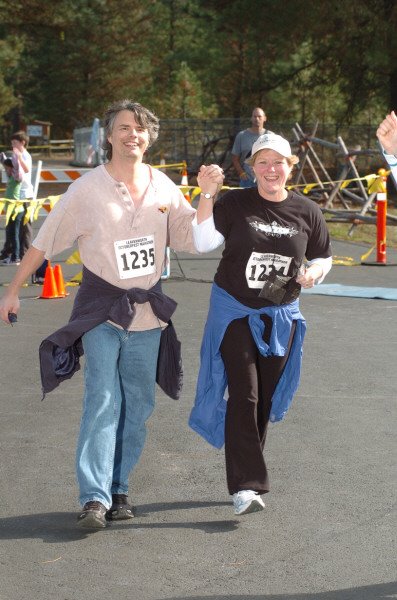
I thought that it might be good to show a set of "before and after" photographs, just so you can see the difference that 50 pounds can make:
 |
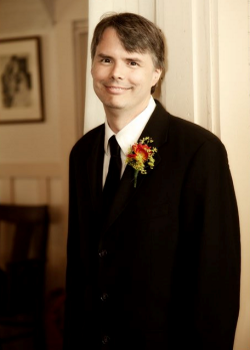 |
| December, 2009 | July, 2011 |
(My thanks to Rebecca Calvo for the photos!)
How Anyone Can Lose Weight
A while ago I posted some weight loss information to Facebook in order to answer a few people's questions about my experiences; since I keep my list of friends on Facebook pretty small, I thought that I'd share some of that information here. But I also wanted to make it a little more up-to-date with some additional information.
My secret to weight loss? Microsoft Excel.
Well, it's a little more than that - but it's mostly just counting my calories and making sure that I eat 1,000 calories less per day than my Resting Metabolic Rate (RMR), for which I use Mufflin equation:
- For Men: (10 x w) + (6.25 x h) - (5 x a) + 5
- For Women: (10 x w) + (6.25 x h) - (5 x a) - 161
Where:
- w = weight in kg
- h = height in cm
- a = age
I converted this equation into the following complex Excel formula:
=((10*(B2/2.2))+(6.25*(B3*2.54))-(5*B4)+IF(B1="Male",5,-161))*IF(B5="Extremely Active",1.9,IF(B5="Very Active",1.725,IF(B5="Moderately Active",1.55,IF(B5="Lightly Active",1.375,1.2))))
Where:
- B1 = Male or Female
- B2 = Weight (in pounds)
- B3 = Height (in inches)
- B4 = Age (in years)
- B5 = Activity Level (Sedentary, Lightly Active, Moderately Active, Very Active, Extremely Active)
To make things easier, I created the following spreadsheet to help me track my calories:
Geeky Bob's Weight Tracking Spreadsheet
If you want to use it, here's how it works - there are two worksheets in the spreadsheet:
- On the Settings worksheet, you enter your weight, height, age, activity level, and the number of pounds that you want to lose in a week. You should only shoot for a maximum of two pounds a week; anything more is really unsafe, and your body will respond by slowing down your metabolism to conserve resources.

- On the Tracking worksheet, you enter the date and your weight, and the spreadsheet uses this information and the information from the Settings worksheet to calculate your Body Mass Index (BMI) which should be below 25, and your Resting Metabolic Rate (RMR) which is the number of calories that your body burns just to keep you alive.
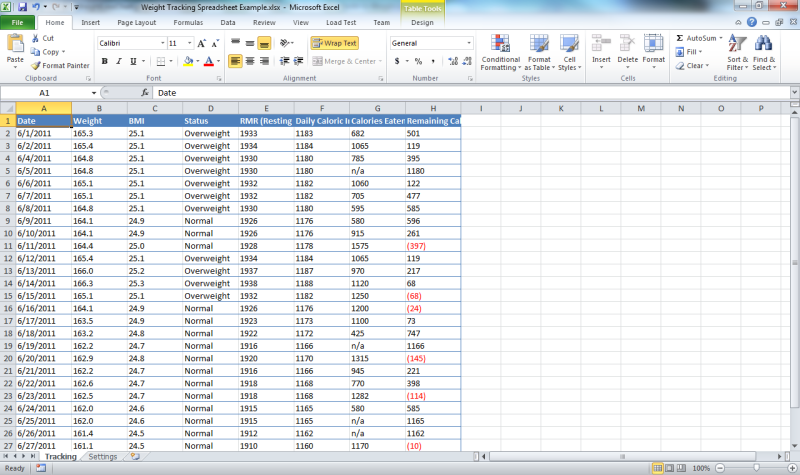
The remaining columns in the spreadsheet will tell you the number of calories that you can eat based on your weight loss goal. As you enter the number of calories that you have eaten (by using a formula like "=100+200+300") the spreadsheet will let you know how many calories that you have remaining for the day. As long as you keep your remaining calories above zero, you should be losing weight.
So there you have it: Microsoft Excel is the Geek's Guide to Weight Loss.
;-]
